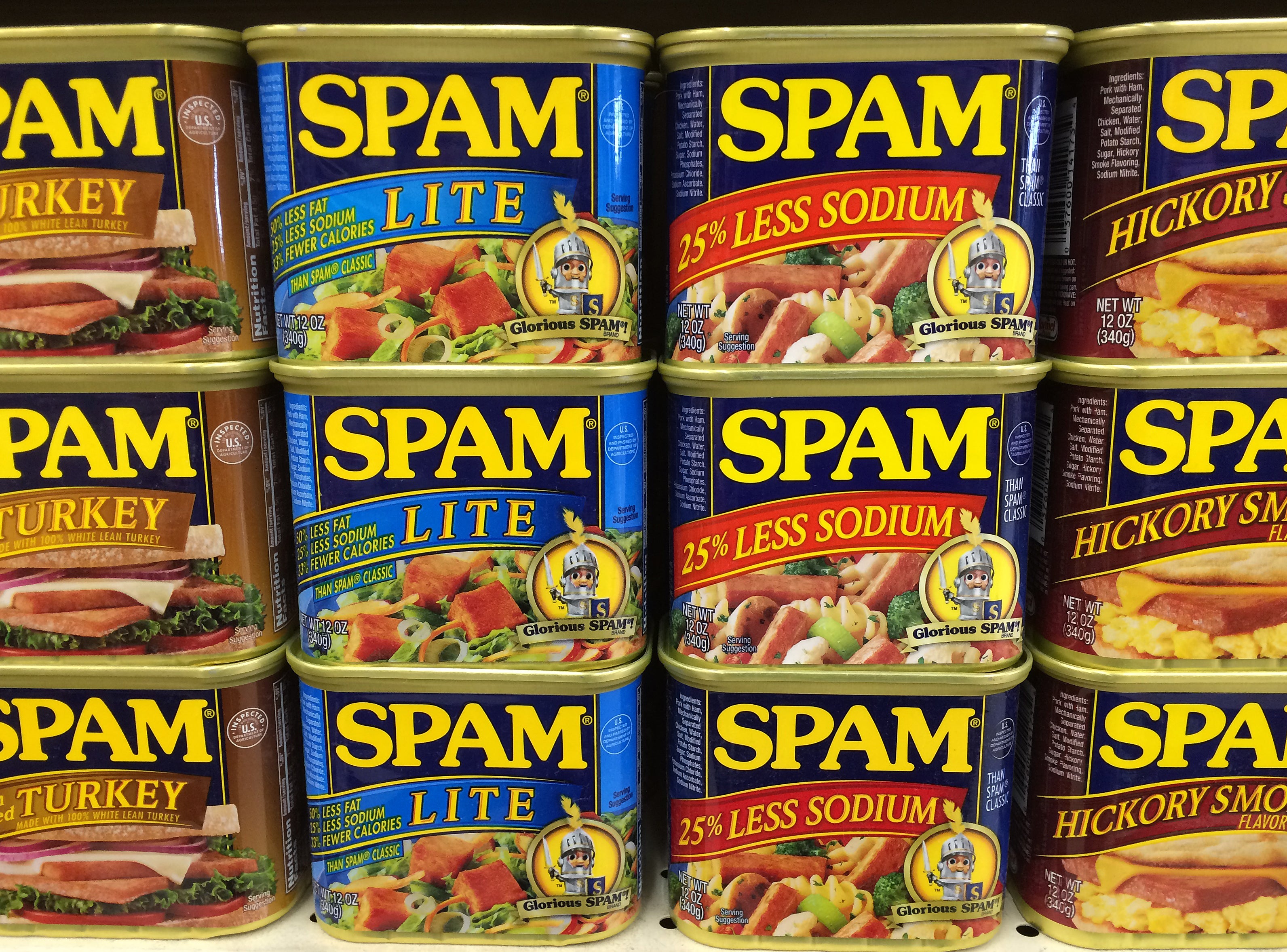Spam occupies an outsize space in the American culinary consciousness as a particularly yecch food. There are a few possible reasons for this. Maybe it’s the grainy, pinkish color and rectangular shape, like something spliced together from a freakish science experiment. Maybe it’s just that World War II veterans got sick of eating can after can in the trenches and eventually passed their negative feelings down to their children and grandchildren. Maybe it’s the way the gelatin slides out from the can in a way that is genuinely gross no matter how you try to spin it. Maybe it’s because it’s meat, delivered sliced and diced on your plate, directly from a can.
Nonetheless, skeptical eaters fortunate enough to encounter a piece of properly cooked Spam will realize something shocking that millions of people around the globe already know: Spam’s really not that bad. It’s actually quite delicious, like a saltier, fattier version of ham—with the discouraging nutritional values to go along with it. But an untreated slice of Spam, daubed with mayonnaise and tucked between two slices of white bread, is a utilitarian meal of the past. Talk about yecch. To make the most of your Spam experience, you grill it or fry it in a pan, manipulating the spongy texture and browning the outsides. It can then be incorporated into dishes like fried rice, budae jjigae—a popular Korean stew—or musubi (Spam rice ball), where the strips of fried Spam add a flavorful bit of protein to some mild rice and seaweed.

Spam was invented before World War II as a way of keeping Hormel workers employed year-round and creating a shelf-stable deli meat. When the war started, it was shipped to soldiers around the world because of its ability to maintain in global temperatures. Since then, a whole slew of flavored varieties have come into existence, comprising an entirely colorful universe of processed meats. The first offshoots were Spam Hickory Smoke and Spam With Cheese, both of which hit the market in 1971. The line has expanded to include 15 flavors of Spam, ranging from the obvious (Spam Lite, which promises less fat, sodium, and calories) to the obscure (Spam Tocino, which is flavored after the popular Filipino bacon).
Some of these were developed for specific markets (in the case of Spam Teriyaki, Hawaii); others, like Spam Chorizo, were made with all consumers in mind. (There have also been limited-edition flavors, like Golden Honey Grail and Stinky French Garlic, introduced as part of a promotion for the Monty Python Spamalot musical.)
The regular Spam—formally known as Spam Classic—is still Hormel’s top-selling brand, but according to brand manager Brian Lillis, they’re always on the lookout for new flavors. “We keep a strong pulse on the culinary and foodie scenes as well as listen to our customers to ensure each new variety created is versatile, easy to use, and above all, great-tasting,” he says. Spam BBQ? Spam Sriracha? The future may be that exciting. In the name of journalism, I sampled an array of alternative Spams in order to help you out the next time you’re at the grocery store and looking to get weird.

Spam Teriyaki
I almost always grill my Spam in a light teriyaki glaze, which prepares it for usage in Asian dishes like stir-fry or musubi (for which there is a recipe on the back of the Spam Teriyaki can). The teriyaki-infused Spam was very sweet, almost glistening with excess sauce. This was the obvious standout, as it’s how you might want to prepare your Spam anyways, though perhaps with a lighter amount of teriyaki than provided.
Spam With Real Hormel Bacon
Hormel offers a wide, wide variety of foodstuffs, such as chili, peanut butter, and, uh, Muscle Milk. But its bacon in particular, with its similarities to ham, makes for a natural crossover with Spam. When sliced thinly and cooked long enough to accrue a nice char, bacon Spam makes a decent substitute for standard bacon. It’s maybe the only variety you’d want to eat on its own, next to a plate of eggs and toast. It’s not going to be any worse for you nutritionally than bacon is.
Spam Chorizo
Maybe I’ve been eating too much so-so Mexican food, but Spam Chorizo struck me as unbelievably close to the real thing, down to the strong paprika scent, the orange-ish coloring, and the peppery kick in the aftertaste. It tasted the least like standard Spam, as the chorizo seasoning was heavy enough to make me forget what I was eating. (The texture, however, was still Spammy; there was none of the gaminess of chorizo.) You could drop this on another breakfast plate, or maybe even stick it in some tacos, if you were ever so bold.
Spam Hot and Spicy
Spam Hot and Spicy lives up to its name; the Spam is indeed hot and definitely spicy. (It’s flavored with Tabasco’s trademarked red pepper mixture.) In fact, it tastes almost exactly like regular Spam, except for a surprisingly strong heat that kicks in when you’re chewing. I can’t see it being in any way good for my digestive system, but there’s a nice novelty to it, if you wanted to incorporate this into musubi for an added kick.
Spam Oven Roasted Turkey
This is Spam made with “100% white, lean turkey,” apparently, instead of the usual pork. It still has the same Spam texture, which means it isn’t quite the natural substitute for sandwich meat that the marketing wants you to believe. The taste was mostly bland, a damning property for a food as delightfully ostentatious as Spam, and the sponginess was fooling no one. Honestly, this was the most conceptually mixed variety—Spam is Spam, not anything else.
Spam Hickory Smoke
Ironically, this tasted much more like turkey-based Spam than the actual Oven Roasted Turkey Spam, though it’s made with mechanically separated chicken (aka the grossest bits of chicken, separated from the bone by brute force). This you could maybe get away with putting on a sandwich. It’s slightly confusing why they’d have two turkey brands, especially since one is noticeably tastier than the other, but redundancy is built into the lineup: Spam Lite and Spam Less Sodium offer basically the same thing.
Spam Garlic
By far the worst flavor, smelling of stale garlic cloves and not tasting much better. Garlic in your Spam is just an awkward collision of flavors—too many contrasting, pungent sensations to give your tongue anything to enjoy in full. The first whiff from the can portended bad things to come, and the cooked thing was equally off-putting. It’s best to just let this go bad on the shelf, though because of all the preservatives, that’ll literally take years.

